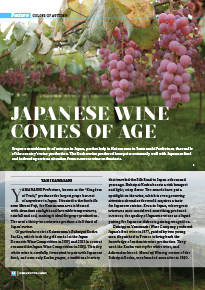Home > Highlighting JAPAN >Highlighting Japan November 2015>Colors of Autumn
Highlighting JAPAN

Colors of Autumn
Japanese Wine Comes of Age
Grapes are emblematic of autumn in Japan, particularly in Katsunuma in Yamanashi Prefecture, the cradle of the country’s wine production. The Koshu wine produced here pairs extremely well with Japanese food and is drawing serious attention from overseas wine enthusiasts.

Yamanashi Prefecture, known as the “Kingdom of Fruit,” produces the largest grape harvest of anywhere in Japan. Situated in the foothills near Mount Fuji, the Katsunuma area is blessed with abundant sunlight and favorable temperatures, rainfall and soil, making it ideal for grape production. The area’s thirty-two wineries produce a full third of Japan’s wine.
Of particular note is Katsunuma’s Rubaiyat Koshu Sur Lie, which took the gold medal at the Japan Domestic Wine Competition in 2005 and 2012 (a contest renamed the Japan Wine Competition in 2015). This dry white wine is carefully fermented to pair with Japanese food, and uses only Koshu grapes, a traditional variety that traveled the Silk Road to Japan a thousand years ago. Rubaiyat Koshu boasts a rich bouquet and light, crisp flavor. The awards have put a spotlight on the wine, which is even garnering attention abroad as the world acquires a taste for Japanese cuisine. Even in Japan, where great wine was once considered something produced overseas, the quality of Japanese wines as a liquid pairing for Japanese dishes is gaining recognition.
Dainippon Yamanashi Wine Company produced Japan’s first wine in 1877, guided by two young men dispatched to France to bring back the knowledge of authentic wine production. They used the Koshu variety for white wine, and Adirondac for red. Marufuji Winery, creator of the Rubaiyat Koshu, was founded soon after in 1890. Today, Haruo Omura, the fourth-generation heir to Marufuji, serves as its president and as the Katsunuma Wine Association’s chairman. He is enthusiastic in his conviction, saying that the company wants to “create a wine out of Katsunuma that can go toe-to-toe with the world.”
According to Omura, Japanese wine used to bring to mind sweet vintages in the style of Port. “Grapes that can withstand Japan’s heavy rainfall have thick skins, and sweet wines make use of sweetness to mask the skin’s inherently bitter and astringent flavor,” he explains. “These wines are what kept viniculture alive in Japan.” After a restaurant chef voiced the concern that Japanese wine did not complement Japanese food well, Omura was motivated to switch to dry wines. In 1989, he adopted the Sur Lie technique to mask the Koshu’s bitterness and develop a richer taste and more fragrant nose. After fermenting the juice, the product is stored directly in tanks without filtering the sediment, bringing out the umami content within the wine. This process is what allowed Koshu wine to transform into something dry, fresh and rich.
“When I returned from training in France, I was under the impression that Chardonnays, Sauvignon Blancs and other European varieties were superior to Koshu,” Omura says. “However, when we tried planting European varieties in the Japanese climate, they did not grow well. The fact that the Koshu variety has managed to withstand Japan’s trying climate for ten centuries is something that should be respected. Whenever making wine, I always ask myself if the product contains the true quality and beauty of the Katsunuma terroir.”
In 2010, Koshu became the first Japanese grape variety to be certified by the European Union. The simultaneously delicate and vivacious qualities of Japanese varieties pair exquisitely with Japanese cuisine, with its abundance of raw seafood ingredients. The finest domestic and international restaurants and airlines, as well as Japan’s overseas embassies, now serve Rubaiyat Koshu Sur Lie.
New varieties of Yamanashi wine are drawn from their casks on November 3 each year. As the crop begins to ripen, the Koshu vineyards are bathed in a beautiful purple, and Omura looks forward to the new season. “We would love to have many more people try Koshu wine,” he declares. “I can think of no greater pleasure than having wine drinkers say that Japanese wine is delicious.”
© 2009 Cabinet Office, Government of Japan






